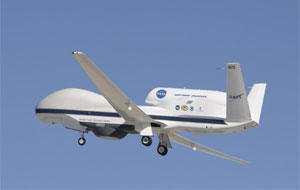Tracking hurricanesDrones being used to track hurricanes
Federal hurricane trackers will start experimenting with unmanned boats and aircrafts to learn more about how to anticipate and track the movements of hurricanes; NASAand the National Oceanic and Atmospheric Administration(NOAA) are teaming up and using a pair of military-surplus Global Hawk spy drones, which are known more for spying on battlefields than chasing storms

A Global Hawk UAV, the drone to be refitted as a hurricane hunter // Source: nasa.gov
Federal hurricane trackers will start experimenting with unmanned boats and aircrafts to learn more about how to anticipate and track the movements of hurricanes.
NASA and the National Oceanic and Atmospheric Administration (NOAA) are teaming up and using a pair of military-surplus Global Hawk spy drones, which are known more for spying on battlefields than chasing storms.
The National Journal reports that drones are not being used in the tracking of Hurricane Isaac, but officials expect to have the program up and running at the height of hurricane season. The first of the two drones is expected to touch down at NASA’s Wallops Flight Facilityin Virginia with a preliminary flight to take place soon after. Officials hope to get the drones prepared for a first test in mid-September.
Storm chasers and researchers have used unmanned aircrafts for years, but with the upgrade in technology since 9/11 and during the war on terrorism, the weather community is taking advantage of the new tools the government has provided.
The Global Hawks will be outfitted with sensors to provide up-to-the-second information for monitoring the storms as part of a 3-year program. For now, NASA is more focused on basic research than weather forecasting.
This may bethe start of something significant, but the drones will not be replacing the manned Hurricane Hunter aircraft that flies directly into hurricanes today. Thereason for that is that while smaller UAVs can withstand the winds and storms of a hurricane, their size does not allow for many sensors to be placed on them. Larger drones like the Global Hawk cannot withstand the extreme weather that a hurricane creates.
The surprise is that while Hurricane Hunter program has been around since 1943, only four aircrafts have been lost, the last one in 1973,making regular air travel seem a lot more dangerous. Scott Braun, a NASA investigator who leads the Global Hawk experiments, knows this is just the beginning of a long plan.
“We are still a long ways away from replacing manned flights,” Braun told NationalJournal.com. Instead, the UAVs will supplement manned flights by flying at altitudes thousands of feet above the thrashing winds and rain, while the NOAA will experiment with smaller drones to enter the storms at sea level.
The Wave Glider is at the front of that line right now. The Glider is a solar- and wave-powered floating platform that can take measurements from both the air and sea and has been used before by weather officials in a variety of experiments.
Another vehicle whichwill be used is EMILY, a 65-inch watertight unmanned surface vehicle outfitted with a range of sensors and a high-definition camera. Scientists hope to guide EMILY into some of the most dangerous parts of hurricanes and tropical storms.
